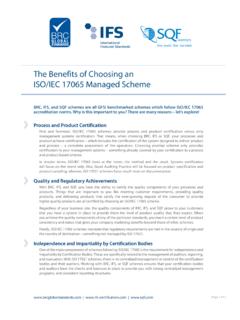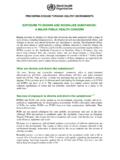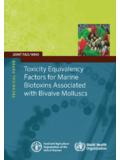Transcription of Dr. Ramakrishnan Nara Technical Program Director Perry ...
1 Dr. Ramakrishnan Nara Technical Program Director Perry Johnson Registrars (PJR, USA) Chemical Hazards- An Introduction Toxic substances and other chemicals that make food unsafe Less apparent than biological hazards Acute toxicity uncommon; Chronic exposure and resulting aftereffects Associated with high profile food safety recalls and withdrawals. Chemical Hazards and HACCP HACCP Principles require identification of chemical hazards during hazard identification and risk assessment stage Appropriate controls to be in place to reduce their potential to occur and impact Common to overlook or incorrectly assess Poor understanding of chemical hazards.
2 Science of toxicology and mechanisms behind the effects of chemicals on human body Toxicology Deals with interaction between chemicals and biological systems Understanding helps in risk assessment and control measures Origin- drugs, food additives, natural toxins, industrial chemicals, environmental pollutants Acute Vs. Chronic toxicity Acute toxicity - An immediate toxic response Chronic toxicity - Toxic response over a long period of exposure Dose-Response Relationship Relationship between level of toxin and adverse response from dose LD 50 (lethal dose that produces death in 50% of exposed organisms) Examples of LD50 Values Chemical LD50 mg/kg.
3 Rats, oral administration Salt 40,000 Ethanol 10,000 Nicotine 1 Dioxin Botulinum toxin Ref: Safe Food 360 White Paper (October 2013) Routes of Entry of Toxins Oral- Most important from food safety perspective; Ingested toxins enter liver and then into bloodstream Lungs-Normally volatile gases or fine dust Skin- Usually lipophilic toxins; skin is a good protective barrier Useful websites on Chemical Hazards Risk Assessment of Chemical Contaminants Exposure assessment, daily intake Dose-response data toxicity testing data from humans or animal data for extrapolation ADI data Mechanism of action of toxic effects Categories of Chemical Contaminants Chemical hazards can thus be divided into five broad categories.
4 Inherent ('Natural') toxins Natural and environmental contaminants Process and storage-derived contaminants Intentionally added contaminants, and Pesticides and veterinary residues Inherent Toxins Occur as regular constituents of food in question Lectins-kidney beans, lima beans, lentils; cooking eliminates toxicity Glycoalkaloids- Solanine and Chaconine in Potatoes; safety limit 200 mg/kg of fresh potato Oxalates- in spinach and rhubarb; high levels found in rhubarb leaves Cyanogenic glycosides: Potential to release cyanides; amygdalin in bitter almonds, cassava (linamarin) Trypsin Inhibitor-Inhibits proteolytic activity.
5 Example,Lima and soy beans Natural Contaminants Mycotoxins: Chemically diverse naturally occurring substances produced by a range of fungi or moulds Example, Af latoxins, Ochratoxin, Patulin, Zearalenone, Fumonisins, Tricothecenes Shellfish toxins: Includes neurotoxic (NSP), diarrhoetic (DSP), paralytic (PSP), amnesic (ASP) fish poisoning; . Natural Contaminants contd. Af latoxins- B1, B2, G1, G2, M1, M2; in peanuts, tree nuts; A. flavus; A. parasiticus; Liver toxins, carcinogens Ochratoxins- A. ochraceus; in green coffee; Teratogenic, carcinogenic Patulin- P.
6 Expansum; carcinogenic Zearalenone- Fusarium species in high moisture corn; endocrine disruptor Tricothecenes- Fusarium sp. (aka vomitoxin) Fumonisins- F. moniliforme; liver and oesophageal cancer Environmental contaminants Dioxins / Polychlorinated biphenyls (PCBs): Found in soil, water, sediment, plants and animal tissue in all parts of the world; present in virtually all foods; highest concentrations are in fatty foods such as oily fish; main sources of dioxins in the diet are meat and milk. Levels accumulate as they move through the food chain.
7 Control options are based on prohibiting the use of dioxins and PCBs by industry and hence their release into the environment; No limits exist in the USA although the FDA considers all detectable levels to be of concern. Environmental contaminants, contd. Polycyclic aromatic hydrocarbons (PAH): PA Hs a re genotoxic. Detected in air, water, soil and foods. Foods may become contaminated through direct environmental exposure, migration from packaging material or during thermal processing of food, baking, grilling, frying and smoking.
8 PAHs in fruit, vegetables and cereals is primarily due to soil and air exposure. High levels reported in smoked meats and animals farmed on contaminated land. Can also be formed during heating and drying processes which allow combustion products to come into contact with food substance. Environmental contaminants, contd. Heavy metals: Commonly, Mercury, Cadmium, Arsenic and Lead Natural components; originate from earth's crust; found all over the world Migration from packaging ( antimony from plastic bottles, and tin in canned food) Crop products may contain high levels of lead and cadmium; Raw material control essential to ensure product safety Maximum levels established in many countries.
9 Important to know legislative limits if exporting Process Based Contaminants Production of toxic chemicals in foodstuffs through processing; recently discovered Acrylamide: Formed in starch-containing foods; Examples are potato products such as crisps and chips, coffee, savory snacks such as cracker type biscuits, and bread Acrylamide is a known carcinogen Process Based Contaminants, contd. Chloropropanols: Occur in foods and food ingredients as a result of processing, migration from packaging materials during storage, or domestic cooking Found in a variety of foods, cooked/cured meats and fish, cheese, bread and toast, malt extracts and baked products, as well as in teabag paper, tissue and sausage casings Occurrence in food following reaction between hydrochloric acid and lipids, particularly in foods processed at high temperatures such as soy sauce.
10 Carcinogen Packaging migrants Transfer of monomers and additives such as plasticizers in plastic packaging materials are the major area of concern A list of approved monomers and additives for use in food contact plastic materials (EU and FDA) General limit for containers and sealing devices is 60 mg per kg of food; for other contact materials it is 10 mg/dm2 Bisphenol A, Semicarbazides, Phthalates Intentionally Added Contaminants Illegal or unauthorized dyes: The Sudan dyes are synthetic azo dyes are not permitted food colors; other dyes include Para Red, Rhodamine B, Orange II, Red G, Butter Yellow and Metanil Yellow Melamine: An industrial chemical found in plastics; a major component in Pigment Yellow 150, a colorant in inks and plastics.









![FERERAL [RCRA-TCLP] AND STATE [TITLE 22-STLC, TTLC ...](/cache/preview/f/1/2/2/d/2/9/c/thumb-f122d29cd25cb54e2601a0dcadd552fd.jpg)

